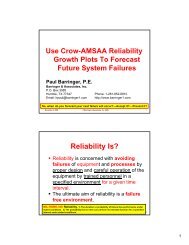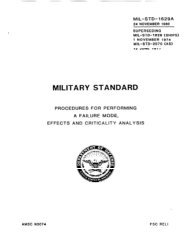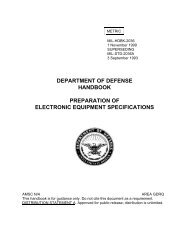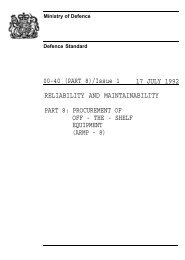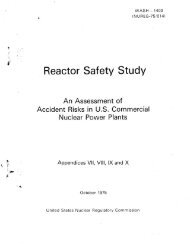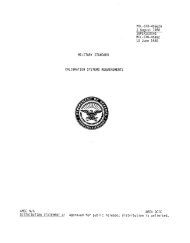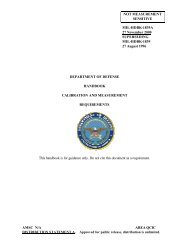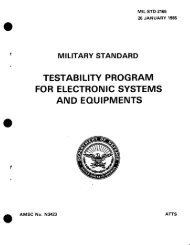Predict Failures: Crow-AMSAA 101 and Weibull 101 - Barringer and ...
Predict Failures: Crow-AMSAA 101 and Weibull 101 - Barringer and ...
Predict Failures: Crow-AMSAA 101 and Weibull 101 - Barringer and ...
- No tags were found...
Create successful ePaper yourself
Turn your PDF publications into a flip-book with our unique Google optimized e-Paper software.
<strong>Predict</strong> <strong>Failures</strong>:<strong>Crow</strong>-<strong>AMSAA</strong> <strong>101</strong> <strong>and</strong> <strong>Weibull</strong> <strong>101</strong>Paul <strong>Barringer</strong>, P.E.<strong>Barringer</strong> & Associates, Inc.P.O. Box 3985Humble, TX 77347-3985USAPhone: 1-281-852-6810FAX: 1-281-852-3749Email: hpaul@barringer1.comWeb: http://www.barringer1.comInternational Mechanical Engineering Conferencehttp://www.imece2004.comKuwaitDecember 5-8, 2004Copyright © 2004 by the Kuwait Society of Engineers. All rights reserved. Page 0 of 14
of tube failures are never disclosed at the oldest age (in this case, 12 years) because an autopsywas not performed on tubes retired. After all, few tubes are found in the failed condition at theearly ages; but you should expect to find many tubes failed at old age <strong>and</strong> this end of lifeinformation would be very valuable for historical records to forecast future failures. Thus withequipment as with humans, autopsies at end of life provide valuable data for future conditions.Don’t miss the opportunity to acquire more data <strong>and</strong> better data by inspecting retired equipment.For emphasis, we cannot know precisely on what date the first heat exchanger tube failed (itfailed some time between time zero <strong>and</strong> three years of time). Nor can we know the individualfailure dates for any of the other ages to failure. Of course, we’re blind for how many failuresexisted at age 12 years when the heat exchanger was removed from service <strong>and</strong> retubed. Unlessthe heat exchanger is inspected <strong>and</strong> failures recorded at year 12, we must extrapolate---in fact theunreported failures at age 12 are very important for future events as the aging process says weshould expected more deaths per year in the period between 11 <strong>and</strong> 12 years. Just as occurs withhuman deaths, autopsies are important events prior to burial <strong>and</strong> the same is true for death ofequipment to set the record straight for future events.We have two deficiencies in data for this heat exchanger: 1) we only know deaths occurred overan interval, <strong>and</strong> 2) we’re blind as to the number of deaths within the interval from 11 years to 12years where data on the old veteran tubes strongly influence the results for predicting futureconditions. Perhaps we can never, in a practical fashion, acquire accurate ages to failure on theheat exchanger tubes, but we can perform an inspection upon removal of the system to pinpointthe deaths occurring in the short interval between year 11 <strong>and</strong> year 12 to give the most accuratetime <strong>and</strong> where we should have expected more failures to occur per unit of time so as tomeliorate data deficiencies.In general, we do not record failures to accurate time scales unless life data is acquired in thelaboratory where precise failure criteria have been established <strong>and</strong> accurate time keepingequipment has been installed. For field failures we may get time recorded to the hour, but morefrequently we’re at best accurate to the day, sometimes we’re only accurate to the week ormonth, <strong>and</strong> as the heat exchanger example illustrates, unknowns in time may be recorded inyears. Many people recognize we need more accurate data to achieve more accurate analysis butlike the weather, we only talk about doing something with making improvements.Typically, reliability data has many errors in recording ages-to-failure. Customarily, <strong>Weibull</strong>analysis recognizes that errors in the X-direction (the time scale) are greater than errors in the Y-direction (the probability scale) on <strong>Weibull</strong> plots. Consequently the <strong>Weibull</strong> data is regressed X-onto-Y recognizing the time axis (X) has the largest errors compared with the median rankplotting positions associated with the Y-axis. Customarily, C-A plots do not recognize the errorcondition in the time scale <strong>and</strong> consequently the customary math technique regresses Y-onto-X.The sad part about failure data is this: Most engineers don’t know how to use the data theyalready have for making better decisions. We seem to operate in a perpetual state of oblivionregarding data! In short: We just don’t get it!Copyright © 2004 by the Kuwait Society of Engineers. All rights reserved. Page 3 of 14
Seventy years ago we accepted that pilots of airplanes could fly in fair weather when they couldsee the ground. Few flights were involved <strong>and</strong> flight by the seat of our pants was acceptable.Today we reject seat of the pants flight, <strong>and</strong> we dem<strong>and</strong> that commercial airline pilots must flytheir planes, navigate, <strong>and</strong> follow precise rules by the numbers. Similarly today we expectmedical doctors must be guided by the numbers for laboratory test <strong>and</strong> careful diagnosis ofhuman ills to find a solution in diagnosis, surgery, <strong>and</strong> pharmacology with medicine by thenumbers. Likewise we even dem<strong>and</strong> that simple disinfection of water <strong>and</strong> treatment of sewagebe performed by the numbers.Most engineers need to underst<strong>and</strong> they are a dying breed if they plan to maintain plants <strong>and</strong>equipment using only the seat of their pants, qualitative data, for making decisions. Engineersmust fluently use reliability data so they can reduce costs <strong>and</strong> avoid failures by using data tomake wise decision. Without the numbers, we engineers will soon be viewed as technicalamateurs with declining pay scales <strong>and</strong> unemployment as the byproduct. Engineers—wake up!Use the data in your maintenance systems to solve technical problems <strong>and</strong> make improvements!The task of reliability engineers is to avoid failures which carry a requirement for solvingproblems with data. The task of maintenance engineers is to quickly restore equipment tooperating conditions which requires underst<strong>and</strong>ing failure modes <strong>and</strong> the failure data. Bothreliability engineers <strong>and</strong> maintenance engineers can use a common set of data for an excellentcommunication tool to solve the vitally few problems in the shortest interval of time using factsfrom the data to reduce costs for our manufacturing plants.Lack of clues, on how to use the data, results in poorer financial performance for our businesses.We often incur higher cost by not giving the data a voice by use of <strong>Crow</strong>-<strong>AMSAA</strong> plots or by<strong>Weibull</strong> plots. Frequently failure patterns give clues for avoiding future failures, <strong>and</strong> we cannotsee the forest for the trees unless we use our analytical tools. Does all data need analysis?—no!Some data on low cost failures does not warrant they higher cost of analysis. Does high failurecosts need analysis?—yes! We need to mitigate the failures by bringing an arsenal of tools intoplay to reduce costs. Give the data a voice to solve the vital few economic problems driven bythe facts <strong>and</strong> not emotions. Make the data talk!Data facts begin with a Pareto distribution of economic problems measure in money (not a nosecount of problems as this establishes the problem solving priority). Data <strong>and</strong> supporting details areoften found in maintenance databases Convert the detailed information into an underst<strong>and</strong>able modelfor solving the problem. Consider the data in Table 1 which can be used two ways: 1) <strong>Crow</strong>-<strong>AMSAA</strong> plots of mixed failure modes <strong>and</strong> 2) <strong>Weibull</strong> plots of individual failure modes.<strong>Crow</strong>-<strong>AMSAA</strong> Plots <strong>101</strong>-C-A plots are simple power curves of cumulative time <strong>and</strong> cumulative failures. The data, whenplotted on log-log paper, usually results in straight lines. Cumulative failures are plotted on theY-axis. Cumulative time is plotted on the X-axis. The math is simple for the regression line,using the equation N(t) = λ*t β , <strong>and</strong> provides two statistics (line slope, β, <strong>and</strong> Y-axis intercept attime t=1, λ). Trend line slope (beta) statistic is a powerful indicator of increasing, decreasing, ora state of no improvement/deterioration. The Y-intercept provides the failure rate at time equalto 1 which is simply a hypothetical value of major interest to allow forecasting of future failures.Copyright © 2004 by the Kuwait Society of Engineers. All rights reserved. Page 4 of 14
C-A plots make reliability visible even with mixed failure modes <strong>and</strong> often without starting thedata acquisition at time zero.Table 1: Raw Data From Maintenance DatabaseEquipment LogEquipment runs 24 hours per day 7 days/weekDate Time Event Maint. Time Cum. Age (hrs) Failure Age (hrs) Comment1/2/88 8:00 Start-up 0.0 Commissioned1/3/88 1:00 Right Shaft Brg Down 17.0 17.0 Bearing failure1/4/88 7:00 Repaired & Up 30.0 17.01/4/88 11:00 Right Shaft Brg Down 21.0 4.0 Bearing failure1/4/88 18:00 Repaired & Up 7.0 21.01/10/88 17:00 Right Shaft Brg Down 164.0 143.0 Bearing failure1/11/88 2:30 Repaired & Up 9.5 164.01/14/88 20:00 Coupling Down 253.5 253.5 Coupling failure1/15/88 10:30 Repaired & Up 14.5 253.511/29/88 3:00 Main Shaft Seal Down 7902.0 7902.0 Main Seal Failure11/29/88 14:30 Repaired & Up 11.5 7902.06/3/89 12:00 Main Shaft Seal Down 12363.5 4461.5 Main Seal Failure6/4/89 3:30 Repaired & Up 15.5 12363.512/16/89 19:00 Mtr Brg-Shaft End Dn 17059.0 17059.0 Mtr Brg-Shaft End Failure12/17/89 23:00 Repaired & Up 28.0 17059.04/17/90 5:30 Main Shaft Seal Down 19945.5 7582.0 Main Seal Failure4/18/90 1:30 Repaired & Up 20.0 19945.512/12/90 15:00 Left Shaft Brg Down 25671.0 25671.0 Bearing Failure12/12/90 23:00 Repaired & Up 8.0 25671.0Consider the data from Table 1 to prepare Table 2 for a C-A plot.Notice the data from Table 1 clearly contains mixed failure modes.Common sense says it is also clear the failures of well designedbearings in Table 1 have lives that are too short as shown by theshort mean time between failure (MTBF) for the system.Inspection of the data that following the coupling failure at time253.5 hours, shows corrections were made to the system thatsubstantially lengthened the time to the next failure—theseconclusions can be obtained simply by inspection.Table 2: C-A DataCumCumMTBFTime<strong>Failures</strong>(hrs/failure)(hours)17 1 17.021 2 10.5164 3 54.7253.5 4 63.47902 5 1580.412363.5 6 2060.617059 7 2437.019945.5 8 2493.225671 9 2852.3Table 2 data is used to construct a <strong>Crow</strong>-<strong>AMSAA</strong> plot in Figure 1 for the aggregate data. Threelines on the plot show a trend line for all the data <strong>and</strong> for the two different régimes. You areallowed to use good engineering judgment to decide which trend line best represents the data.The first four data points reflect the poor performance of the system whereby the bearings werekilled (most likely because of faulty alignment)—but corrective action has cleared up the infantmortality problems. The last five data points better represent the system response whereas thetrend line from using all the data is a smeared-over trend line that is substantially influenced bythe bad behavior of early failures.Copyright © 2004 by the Kuwait Society of Engineers. All rights reserved. Page 5 of 14
Figure 1: <strong>Crow</strong>-<strong>AMSAA</strong> Plot Of Data From Table 2The early failures are represented by the statistics λ=0.5596 <strong>and</strong> β=0.355 for the “ancient”history. We have little interest in this phase of the data as corrective actions have beenimplemented.The most current history is represented by the statistics λ=0.05116 <strong>and</strong> β=0.509 which will beused to make a “fearless forecast” of future failures for the system using the equationN(t)=λ*t β . Solving the equation for cumulative time gives t=(N(t)/λ) (1/β) . We can forecast thenext failure, failure number 10, will occur at t=(10/0.05116) (1/0.509) = 31704.3 hours which isforecasted as 31704.3 – 25671 = 6033.3 hours into the future.Skeptics will now say you cannotforecast the future with anyaccuracy. So simply try thisexperiment using the data in Table2 as unfolded in Table 3 as thedataset develops over time. Theforecasted failures are roughlywithin 10% of the actualcumulative times as observedfrom the error data—more dataTable 3: C-A Forecast Using Small Data SetCumCumCumCumCumCumTimeTimeTime<strong>Failures</strong><strong>Failures</strong><strong>Failures</strong>(hours)(hours)(hours)12363.5 6 12363.5 6 12363.5 617059 7 17059 7 17059 719945.5 8 19945.5 825671 9λ = 0.06587 0.01836 0.05116β= 0.479 0.614 0.509Fcst (hrs) = 22468.3 8 24083.0 9 31704.3 10∆ Time (hrs)= 5409.3 4137.5 6033.3Error (hrs)= 2522.8 -1588.0 ?Copyright © 2004 by the Kuwait Society of Engineers. All rights reserved. Page 6 of 14
educes forecast errors. Of course we cannot know the actual time for failure number 10 becauseit is not listed within Table 1.So how would you use the fearless forecast of future failures? Use the data for resourceplanning, develop strategies for preventing the next failure, establish a predictive maintenancewatch on the equipment to shut it down just before destructive events occur, etc. Use the datawith fearless forecast to also demonstrate your corrective actions have avoided the predictedfailures for superior results by avoiding failures. Use the data to avoid the perpetual state ofcluelessness so prevalent in many production <strong>and</strong> maintenance departments! Ah Ha!---If youcan predict the failures can you prevent them? Consider the C-A plot for chemical plant safetydata shown in Figure 2—then you decide.Figure 2: <strong>Crow</strong>-<strong>AMSAA</strong> Plot Of Actual Safety Data From A Major Chemical PlantThis graph predicted next safety incident to occurOn May 16, 2004. Actual occurred May 11, 2004.“If you can predict it, you can control it.”Localize bad trend!When:β < 1 failures come slowlyβ >1 failures come fasterβ = 1 no improvement/deteriorationN(t) = λt βThe data for Figure 2 concerning safety incidents is described in Table 4.Clearly safety incidents stem from a multitude of reasons, <strong>and</strong> clearly everysafety incident is a failure of the system to prevent the failure. Most peoplereject the idea that safety incidents are predictable! However, I have beenstudying the safety phenomena <strong>and</strong> straight lines on log-log plots since1967. Time after time straight line segments appear on log-log paper.When significant improvements occur in safety programs, cusps appear inthe data <strong>and</strong> the trend line forms at a flatter slope to illustrate improvementshave been achieved <strong>and</strong> reductions in failure rates are occurring. SinceCopyright © 2004 by the Kuwait Society of Engineers. All rights reserved. Page 7 of 14
humans are involved in the safety incidents, you must involve the same humans in the solution<strong>and</strong> this requires you have simple graphical plots for predicting future events <strong>and</strong> for displayingsignificant improvements have been demonstrated. Thus C-A plots are excellent tools fordisplaying improvements involving the reliability of humans <strong>and</strong> systems.Figure 2 also emphasizes the importance of the statistic beta which describes the slope of the trendline. Time after time we see safety programs with cusps forming where the trend line shoots off inthe wrong direction with increasing beta slopes <strong>and</strong> no one is actively working to turn around theundesirable results. If you don’t have the clear graphics of a C-A plot you cannot formulate clearbattle plans for corrective action. You can conclude the obvious: You must make reliability issuesvisible so each team member can underst<strong>and</strong> what is happening, <strong>and</strong> make it as obvious as the noseon your face, otherwise, bad results occur <strong>and</strong> become the accepted norm.We have other data in the public domain that can help us make predictions concerning futurefailures. Consider that data from the USA space shuttle. Two shuttles have been lost: 1) TheChallenger space shuttle was lost on flight number 25, <strong>and</strong> 2) The Columbia space shuttle waslost on flight 113. Using these two data points obtained from the NASA database athttp://science.ksc.nasa.gov/shuttle/missions/, when is the next space shuttle loss predicted?Figure 3: <strong>Crow</strong>-<strong>AMSAA</strong> Forecast Of Next Space Shuttle LossFigure 3 forecasts the next shuttle failure at flight number 273 based on the extrapolated trendline where the line crosses failure #3. Figure 3’s line slope shows beta = 0.459 which tells ofCopyright © 2004 by the Kuwait Society of Engineers. All rights reserved. Page 8 of 14
significant improvements at NASA to grow the time interval between failures even with agingequipment. As noted in Figure 2 when β1, failures come more quickly thus the line slope has important physicalrelationships about failure rates. Both beta <strong>and</strong> lambda are required for making future forecasts.Your first thought might be how can you predict space shuttle failures based on only two datapoints: 1) two data points is all you have <strong>and</strong> two more than you really want to have recordedconsidering the large loss of life <strong>and</strong> extreme expense, 2) it is better to make the most reasonableforecast you can to give the data a voice, <strong>and</strong> 3) the line slope tells if failures are coming slower,faster, or without significant changes. C-A plots are reliability growth plots.The task of reliability engineers is to make improvements to reduce the failure trend lines <strong>and</strong>thus make a cusp appear on the C-A plots to signify progress. A clear cusp, based onimprovements, are shown for the world’s most unsafe railroad (length of the light-rail road is 7.5miles long) in Houston, Texas as shown in Figure 4.Figure 4: Houston, Texas Light Rail Line AccidentsThe triangular data points show the early accidents prior to implementing improvements. Theinverted triangular data points show a reduction in failure rates after the improvement program.The cusp is clear, <strong>and</strong> improvement has occurred. Extrapolating the trend line to the end of 2004suggests 235 failures would have been expected by December 31, 2004 which is 408 cumulativedays. Extrapolating the improvement trend line in a similar manner shows 78 accidents areexpected. Improvements have occurred, a reduction of 157 accidents are projected to occur inCopyright © 2004 by the Kuwait Society of Engineers. All rights reserved. Page 9 of 14
the time interval. The plots are “show me, don’t tell me” about improvements where mixedfailure modes occur.C-A plots similar to Figure 4 visually shows improvements have occurred to reduce accidents.Furthermore the simple graphic allows quantification of how much of an improvement has reallyoccurred during a time interval to justify the improvement programs. Likewise, the line slopes ofthe C-A plots are helpful in determining how much improvement/deterioration has reallyoccurred. Remember this methodology provides simple forecast from straight lines which makes“sales” presentations easy to underst<strong>and</strong>.These few examples show the power of simple data sets converted into simple plots to makepractical forecast of future failures. More details on <strong>Crow</strong>-<strong>AMSAA</strong> plots are available on theInternet (<strong>Barringer</strong> 2003) <strong>and</strong> the WinSMITH Visual software is used to make the plots (Fulton2004).<strong>Weibull</strong> Plots <strong>101</strong>-<strong>Weibull</strong> plots are simple probability plots which h<strong>and</strong>led tailed data of age-to-failureinformation. Age-to-failure data is plotted in rank order on the X-axis. Median ranks plottingpositions are used on the Y-axis to get straight lines on the probability plot. Probability plotsusually show the cumulative percentage of the population expected to fail by a given age basedon the sample of data supplied for analysis. <strong>Weibull</strong> plots have been found extremely utilitarianfor use with tailed data as usually occurs with the life of components in industry. Thus frugaldata sets can provide maximum information without the usual hedge of “assuming the data isreasonably normally distributed” which frequently results from dem<strong>and</strong>ing use of Gaussi<strong>and</strong>istributions. The <strong>Weibull</strong> distribution is the tool of choice for reliability analysis of life data<strong>and</strong> more information is given in Abernethy (2002).<strong>Weibull</strong> plots of component failures by a single failure mode produce three statistics:1) Line slope beta is often referred to as a shape factor,2) Location parameter eta which occurs where the trend line cuts the 63.2% CDF(cumulative distribution function) as a mathematical property of the <strong>Weibull</strong> distribution,3) Goodness of fit parameter r^2 known as the coefficient of determination or a pve%know as a p-value estimate.For component <strong>Weibull</strong> plots of single failure modes, the <strong>Weibull</strong> line slopes, beta (not to beconfused with the C-A line slopes also known as beta), have physical significance:1) Beta < 1, infant mortality characterized by a declining instantaneous failure rate withtime,2) Beta = 1, chance failures have a constant instantaneous failure rate with time, <strong>and</strong>3) Beta > 1, wear out failures characterized by increasing instantaneous failure rate withtime.The important issue is that <strong>Weibull</strong> plots of component failure data tells you how things die. Atypical observation by non-<strong>Weibull</strong> analysis often defines a failure as “wear out” whereasperforming a <strong>Weibull</strong> analysis of component failures provides considerable enlightenment thatthe motivator for end of life is a different failure mechanism than verbalized.Copyright © 2004 by the Kuwait Society of Engineers. All rights reserved.14Page 10 of
For selection of a maintenance strategy it is very important to know the actual failure mode forcomponents characterized by the <strong>Weibull</strong> beta value:1) Beta < 1, for infant mortality, is a run to failure strategy. An old part is better than anew part because the failure rate is lower as weak units have been eliminated from thepopulation.2) Beta = 1, for chance failures, is a run to failure strategy. An old part has the samefailure rate as a new part. Thus nothing is gained by a replacement strategy whichthrows away unused life until the failure mode changes to a wear out mode.3) Beta > 1, for a wear out failure, may have an optimum replacement strategy if thecost or safety consequences have a very high cost ratio for an unplanned failurecompared to a planned replacement cost which then drives a preventive replacementstrategy. if unplanned replacement cost or safety costs are not much greater than aplanned replacement costs, then the maintenance replacement strategy may be run tofailure controlled by economics.The basic issues are to know the signals for taking action <strong>and</strong> tempering the signals by theeconomics. <strong>Weibull</strong> beta values are driven by the physical failure data taken from CMMS. Inshort, let the data talk <strong>and</strong> give it a voice through <strong>Weibull</strong> analysis.Consider the data in Table 5 containingage-to-failure data for a rotating seal. Thedata produces the <strong>Weibull</strong> plot in Figure5. The age to failure data is based on theoperating ages derived from the birth date<strong>and</strong> the death date—in short, how old wasthe component before it failed. The Y-axis plot position information is obtainedfrom Bernard’s median rank equation.Bernard’s plot position is generallyconsidered best practice for reliabilitydata <strong>and</strong> is explained by the equation (i-Table 5Age-To-FailureX-axis:Age-To-FailureY-axis:Plot Position(days) Order Ranked %1264 1 25 7.45%1339 2 163 18.09%25 3 224 28.72%359 4 244 39.36%537 5 359 50.00%224 6 537 60.64%163 7 775 71.28%244 8 1264 81.91%775 9 1339 92.55%0.3)/(N+0.4) where i is the rank position for ordering the data <strong>and</strong> N is the number of data pointsin the data set. Bernard’s equation is explained in Abernethy (2002).The <strong>Weibull</strong> plot in Figure 5 shows a good curve fit with the coefficient of determination (r^2)greater than the critical value of 0.8464 which leads us to conclude that all is well with the<strong>Weibull</strong> plot. However, you should consider why a well designed seal, properly operated,should have an infant mortality failure mode (β
Figure 5: <strong>Weibull</strong> Plot Showing Infantile MortalityFurther consideration of the data shows that some failures resulted from process errors that killedthe seal rather than the seal dying on its own. Thus we must h<strong>and</strong>le the data in censored(suspended) form rather than naively taking the data at face value based on a good curve fit!Basically, Figure 5 tells you how the system is performing rather than how the seal is performingbecause the system has mixed failure modes.Table 6 shows the corrected data. Bernard’smedian rank is corrected for the suspended data,shown with a minus sign to signify it issuspended. A careful study of the data resultedin ~63% of the data representing suspendeddata which tells you immediately that to achievelong seal life you must correct the genocideoccurring from how the seal is used. Thecorrection in Bernard’s equation is achieved byuse of Auth’s approximation which is alsoexplained in Abernethy (2002). For most of us,Table 6Corrected For SuspensionsAge-To-FailureX-axis:Age-To-FailureY-axis:Plot Position(days) Order Ranked %1264 1 -25 suspended1339 2 -163 suspended-25 3 -224 suspended-359 4 -244 suspended537 5 -359 suspended-224 6 537 18.09%-163 7 -775 suspended-244 8 1264 46.45%-775 9 1339 74.82%it is impossible to remember all the arcane rules associated with how to calculate the plottingposition, so it is an advantage to use WinSMITH <strong>Weibull</strong> software (Fulton 2004) which follows allthe best practice rules outlined in The New <strong>Weibull</strong> H<strong>and</strong>book. Please note that suspended data isnot plotted but the suspensions are used in the data set for corrected plotting positions.Copyright © 2004 by the Kuwait Society of Engineers. All rights reserved.14Page 12 of
Figure 6 shows the plot of data from Table 6.Figure 6: Seal Failure Data With Suspensions Correctly IdentifiedNotice the β>1 tells you the seal has a wear out failure mode <strong>and</strong> the r^2 value represents a goodcurve fit for the three ages to failure when considered against the critical value of r^2=0.7921.The eta value says the seal has a characteristic life of 1293 days when it is operated withoutgenocide conditions. This clearly says we need to correct operating conditions to get long seallife <strong>and</strong> a wear out failure mode.Maintaining a <strong>Weibull</strong> failure data base for your operating conditions provides important history.For example, many heat exchangers have a wear out failure mode with 3 < β < 15 depending uponthe specific way the tubes can fail. Usually we can expect to see a general corrosion β≅3, however,if the corrosion rate is severe, then β≅9, <strong>and</strong> if bad things are happening very fast, then β≅15.Consider the heat exchanger tube life data in Table 7. When will the next heatexchanger tube fail? The data represents one failure at age 7 years with 142survivors at age 7 years. All future failures will come from today’s survivors.Failed tubes are usually plugged rather than replaced with roughly 10% loss oftubes representing the point where the heat exchanger has reached end of life.Table 7Age-To-Failure(years)7-7*142Copyright © 2004 by the Kuwait Society of Engineers. All rights reserved.14Page 13 of
Using the range of beta valuesfrom the <strong>Weibull</strong> data base wecan make three Weibayesforecast values: one forecastfor β=3 will show the nextfailure occurring far out into thefuture, one forecast for β=9 which will show a mid range forecast, <strong>and</strong> one forecast for β=15 willgive the most pessimistic time for when the next failure will occur. Taking the data from Table 7<strong>and</strong> making a Weibayes forecast using the beta value ranges with WinSMITH <strong>Weibull</strong> software willallow an Abernethy risk forecast which is summarized in Table 8. Table 8 tells us what to expectinto the future. We can set up a watch to test for future failures. Roughly 80% of heat exchangerswill display a β≅3 so we have good odds that a calamity might not occur. Forewarned is forearmedfor prudent management.Summary<strong>Crow</strong>-<strong>AMSAA</strong> reliability growth plots with straight lines on log-log plots make reliability datavisible. <strong>Crow</strong>-<strong>AMSAA</strong> plots allow demonstration of failures avoided by corrective actiontechniques. <strong>Crow</strong>-<strong>AMSAA</strong> plots work well with mixed failure modes <strong>and</strong> will provide usefulinformation without starting the plots at time zero. <strong>Crow</strong>-<strong>AMSAA</strong> plots allow forecast of futurefailures for hardware <strong>and</strong> safety events.<strong>Weibull</strong> plots of component failures using age-to-failure data provide useful information aboutfailure modes with the trend line statistic beta. Knowing the beta value allows structuring themaintenance strategy. Useful libraries of information are obtained from knowing the line slope betavalues <strong>and</strong> characteristic age to failure eta statistics. Knowing how things fail gives detailedforecast of future failures which is important for logistics <strong>and</strong> maintenance manpower dem<strong>and</strong>s.Make your data talk. Provide the graphics to help sell your ideas. Prevent failures <strong>and</strong> save money.ReferencesTable 8 Years Into The Future For Forecasted <strong>Failures</strong>Age-To-Failure Future <strong>Failures</strong> β=3 β=9 β=15(years) 1st failure 1.8 0.6 0.37 2nd failure 3.1 1.0 0.5-7*142 3rd failure 4.2 1.2 0.8Abernethy, Robert B, The New <strong>Weibull</strong> H<strong>and</strong>book, 4 th edition, published by the author, NorthPalm Beach, FL, 2002<strong>Barringer</strong>, H. Paul, November 2003 Problem Of The Month—<strong>Crow</strong>-<strong>AMSAA</strong> Plots,http://www.barringer1.com/nov03prb.htm , 2003.Fulton, Wes, WinSMITH Visual software, version 4.0WJ, Fulton Findings, Torrance, CA,(2004)Fulton, Wes, WinSMITH <strong>Weibull</strong> software, version 4.0WJ, Fulton Findings, Torrance, CA, (2004)© <strong>Barringer</strong> & Associates, Inc. 2004Copyright © 2004 by the Kuwait Society of Engineers. All rights reserved.14Page 14 of



